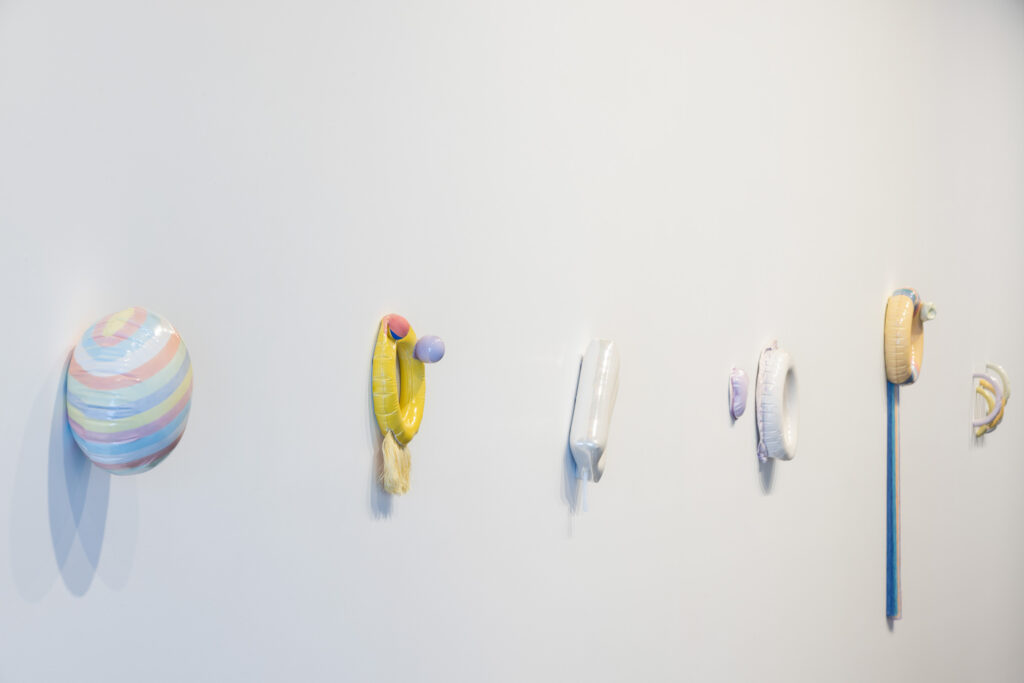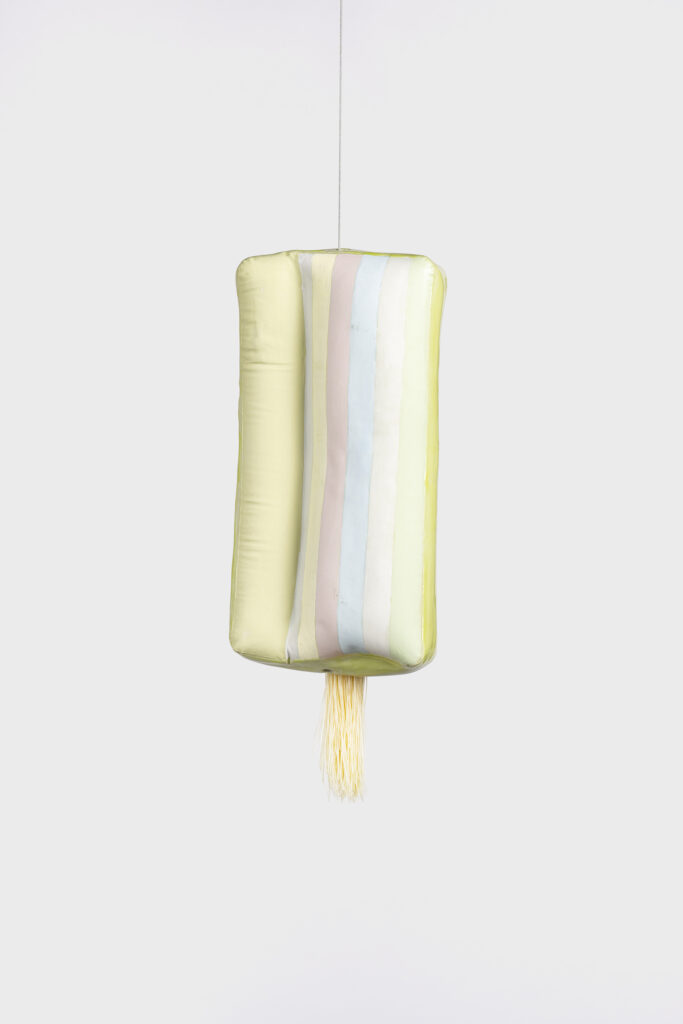
It’s late afternoon and Susie Choi is guiding me through her new exhibition Searching Chords at Mitchell Fine Art in Brisbane’s Fortitude Valley. Warm light reflects off the white walls and polished concrete floor, emphasising the pearlescent glazes and gold details that are a feature of Choi’s ceramics.
I have been waiting impatiently to see this exhibition, Choi’s first since her impressive debut Island of misfit buoys was held in the same space just over a year ago. Choi appeared then to have burst into Australia’s art scene fully formed. Having only graduated from the National Art School in 2021, she was a virtual unknown. Now the Sydney-based Choi is garnering national attention, winning prizes, and sustaining solo exhibitions; little surprise for an artist who takes the cool medium of porcelain slip and turns it into something tender and humane.
Historically the wonder of ceramics has been in the creation of handmade flawlessness, particularly for those of us who can barely coil clay without embarrassing ourselves. Impeccably constructed orbs, impossibly large bowls that somehow manage not to slump, handles that are evenly aligned, glaze that doesn’t bubble or crack. Even Choi’s contemporaries such as Nicolette Johnson, Juz Kitson, and Vipoo Srivilasa, whose implausibly intricate and expansive artworks continue to redefine Australian ceramics, evoke awe for their ability to create something so immaculately balanced from a medium so prone to failure. But for Choi the pursuit of perfection is secondary to the desire to create something honest and true.
At first glance it’s very easy to classify Choi’s work as pretty or decorative, because, well . . . it is. Her distinctive style straddles painting and sculpture, engaging with colour, composition, and structure while embracing chance and creative impulses. Her forms are quirky and tactile, moulded from disparate items that shouldn’t really work together, such as inflatable toys and familial objects she recreates out of cardboard. Some are instantly recognisable, like the blow-up swim ring that features regularly. Another arrangement of squared forms echoes cuisenaire rods, the mathematical learning aides. Many seem to be in a state of inflation or deflation─some appear to float or hover, while others cave, sink, and fold back in on themselves.
Despite being inherently fragile, very few of Choi’s works are made to sit on stable surfaces. Most are wall-mounted or hang from the gallery’s high ceiling on fine wires, looking from a distance like a row of tiered lanterns and foil balloons. The improbability of ceramics being displayed so precariously creates an absurdist ‘Alice Through the Looking Glass’ effect. I can’t help but wonder how her nerves, and those of her gallerists, can withstand the installation process. This tension is paramount for Choi, who claims to know a form is working if it makes her laugh.
But there is also a deeply personal aspect to the work inspired by Choi’s cultural inheritance, though her forms carry the weight of this history lightly. Which isn’t to say the references are shallow; rather that Choi appears to be confronting emotionally-charged subjects and pushing the conversation forward in a way that is both redemptive and therapeutic.

Choi came to visual art later in life, which perhaps accounts for a more nuanced consideration of identity and otherness. Her experience as a child of migrant parents is subtly reflected in her work through glazes that replicate the seven colours of a saekdongot, the traditional Korean hanbok worn by children. In Searching Chords, this reference is made more explicit by the addition of hand strung tassels and bindings. The combination of colours in the striped saekdong pattern is traditionally said to elicit harmony, while the rainbow depicts thoughts of children’s pure dreams. Here, there are two versions of saekdong – one, the customary colourway called obangsaek; the other, Choi’s more contemporary interpretation in pastel candy colours. It doesn’t require a huge leap of imagination to read this as reflective of a chasm between her parents’ dreams and her own─an idea further enhanced by a suspended ring titled Union that intersects both colourways.
In the exhibition’s catalogue, Choi writes:
“Identity isn’t really something you can grasp. Even if you could, I suspect you wouldn’t actually want to keep hold of it. It’s often wrapped up in complexities related to memory, perception and generational trauma. Plus, it’s always in flux, so once the moment has passed, it’s probably time to readjust anyway.”
Searching Chords finds a delicate balance between cultural legacy and joyful play. One of the most striking works is a marigold-glazed ring (When The Wind Changed, 2024)which looks like it’s embedded with a rubber ball, though Choi assures me it’s just matte red glaze. “This one is an outlier. It doesn’t really go with anything else but I love it. It’s funny . . . of all the things Asian people might get called, ‘yellow’ is weirdly one that I don’t have a problem with.”
When I ask Choi how much of her own biography should be read into her art practice, she shrugs. “My works hold cultural significance inasmuch as shapes like the inflatable ring speak to Australian beach culture and representation, or lack of. But it’s as much a gut response to the unpredictable nature of ceramic as it is my personal story.” She points to a work titled Diphthong. “I moulded that one from an inflatable jukebox because I was drawn to the shape, but when I cast it I immediately saw tteok, the Korean rice cakes.”
Despite featuring over 30 discrete objects, there’s a lot of space in the exhibition, which gives each piece the opportunity to breathe and be seen from various sightlines. This allows for multiple connections and points of reflection. Looking back through the exhibition from the furthest corner of the gallery, you get a panoramic view of Searching Chords in its entirety. From here, it looks less like a series of works and more like a personal landscape of influences.

A gentle draft of air slowly turns one of the suspended works (Busted, 2024) away from me, and I notice Choi has left the verso purposefully unfinished. You can see how its lemony tassel is held in place, and beyond, its unglazed centre. This glimpse of Busted‘s interior gives the work a melancholic vulnerability, and I can’t help but feel a twinge of empathy for it. Of all the physical or emotional responses, I’ve had to visual art, feeling compassion for a ceramic was not on my bingo card. But such is the anthropomorphic charm of Choi’s art practice.
Carrie McCarthy is a writer and museum professional, and the Collection Manager at Griffith University Art Museum. She lives in Meanjin (Brisbane), on the lands of the Jagera and Turrbul people.



